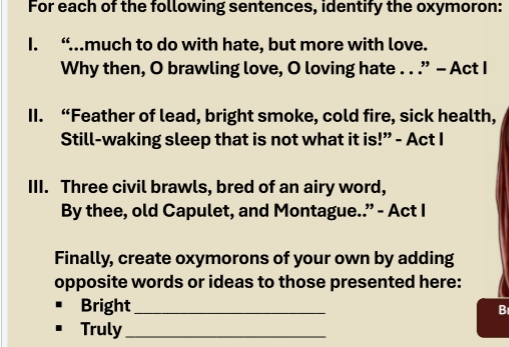For each of the following sentences, identify the oxymoron: I. “...much to do with hate, but more with love. Why then, O brawling love, O loving hate...” – Act I II. “Feather of le... For each of the following sentences, identify the oxymoron: I. “...much to do with hate, but more with love. Why then, O brawling love, O loving hate...” – Act I II. “Feather of lead, bright smoke, cold fire, sick health, still-waking sleep that is not what it is!” – Act I III. Three civil brawls, bred of an airy word, By thee, old Capulet, and Montague.” – Act I Finally, create oxymorons of your own by adding opposite words or ideas to those presented here: Bright _________________________ Truly ________________________.

Understand the Problem
The question is asking to identify the oxymorons in the provided sentences from a play and also to create new oxymorons by pairing opposite words or ideas. This involves analyzing the sentences for contrasting phrases that form a new meaning.
Answer
'brawling love', 'loving hate', 'bright smoke', etc.
The oxymorons are: I. 'brawling love' and 'loving hate'; II. 'feather of lead', 'bright smoke', 'cold fire', 'sick health', 'still-waking sleep'; III. 'airy word'. New oxymorons could be 'bright darkness' and 'truly false'.
Answer for screen readers
The oxymorons are: I. 'brawling love' and 'loving hate'; II. 'feather of lead', 'bright smoke', 'cold fire', 'sick health', 'still-waking sleep'; III. 'airy word'. New oxymorons could be 'bright darkness' and 'truly false'.
More Information
An oxymoron is a figure of speech that combines contradictory terms to reveal a paradox or complex truth.
Tips
Common mistakes include confusing oxymorons with simple contradictions or failing to recognize the juxtaposition of ideas.
AI-generated content may contain errors. Please verify critical information